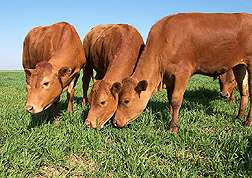Doppler Ultrasound Helps Scientists Understand Fescue Toxicosis

(PhysOrg.com) -- Doppler technology -- the very same technology used by meteorologists to track thunderstorms -- is being used by Agricultural Research Service (ARS) scientists to better understand the rate at which fescue toxicosis restricts blood flow in cattle.
Tall fescue is the predominant grass used for grazing in the United States. But more than 80 percent of the tall fescue in the "Fescue Belt" region—the transition zone between the temperate north and the subtropical south—is infected with an endophytic fungus. Once consumed, the fungus produces ergot alkaloid toxins that cause fescue toxicosis in grazing animals, costing the livestock industry nearly $1 billion annually in lost production.
Doppler ultrasound technology is being used by researchers at the ARS Forage Animal Production Research Unit (FAPRU) in Lexington, Ky., to help better understand the causes of fescue toxicosis and to expedite development of management approaches to alleviate it. The research is led by animal scientist Glen Aiken. FAPRU research leader Jim Strickland was a collaborator in the project.
The ergot alkaloids in tall fescue constrict blood flow. Using the Doppler technology, the ARS scientists found that blood flow decreases within 24 hours of feeding cattle ergot alkaloids. Results show that in cattle consuming diets containing ergot alkaloids, blood flow through the caudal artery—which supplies blood to the tail—can be reduced by as much as 50 percent compared to cattle on alkaloid-free diets. Constricted blood flow to peripheral tissues, such as the tail, reduces the animal's ability to dissipate body heat, making it vulnerable to heat stress.
The research has helped the scientists better understand ergot alkaloids and the mechanisms by which they cause toxicosis. This knowledge could lead to improved forage and animal-management protocols that decrease exposure or enhance tolerance to the alkaloids of endophyte-infected tall fescue.
Provided by USDA Agricultural Research Service



















